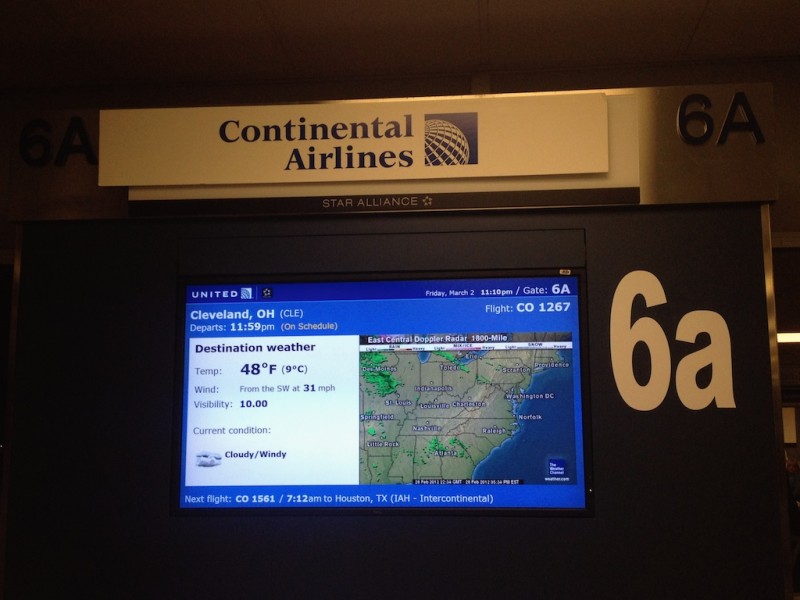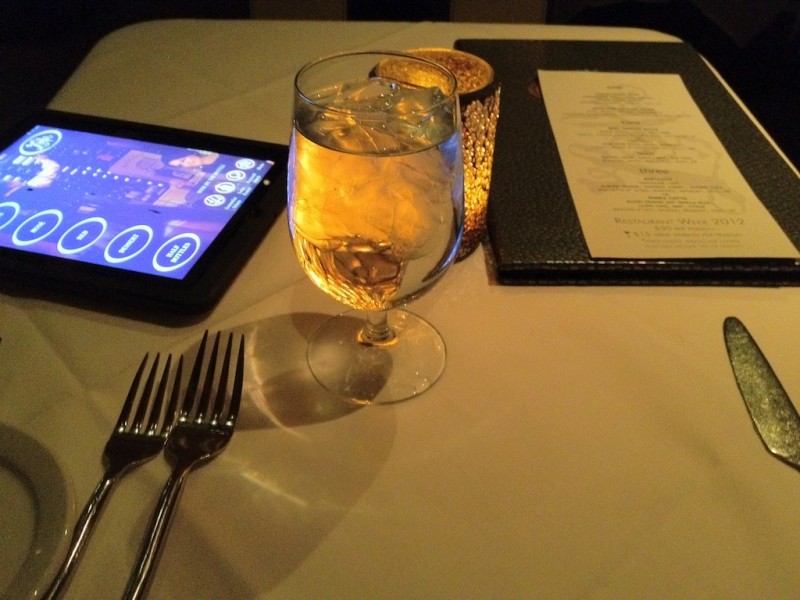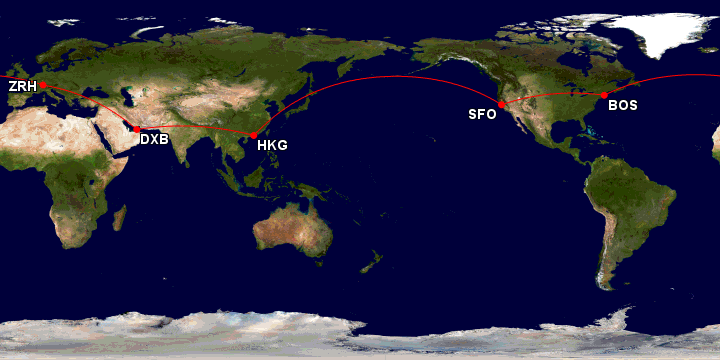Bridges crossed: 1 (Guglie across the Cannaegio canal)
Travel-wise (and obviously excluding the death of my mother-in-law), everything was going entirely too well, right? Well, all that was about to change. Today, I’d wind up in France by accident.
I woke up at 3:30 to finish packing my luggage, am downstairs a hair after 4, and check out of my room (which seems to take an eternity, but they were training someone new). They called a cab who didn’t show up, so they had to call again.
I’m supposed to check my bags in 150 minutes early, but the counter opens at 5am and my flight’s at 6:10am, so I am relieved to get there at 5:02. They reprint my boarding passes as their computer for reading the online-printed ones is down.
We’re all waiting at the gate (which is pretty shabby, fwiw), but at 5:30, no crew’s at the gate. There’s an announcement: the flight’s delayed; the inbound crew were delayed and there are strict rest requirements. I have no problem with that, but I do have a problem with missing an hour’s sleep that the airline knew about the night before. I also have a problem with them not having known to re-book me at the desk when I arrived, but kicking the rebooking over to Amsterdam’s transit desks (which was probably the better plan, though). I had 90 minutes of stopover in Amsterdam, and I have to transit from a non-Schengen area (silly UK) to the Schengen one, which means security. That means I’m almost certain to miss my flight.
For those of you who don’t travel enough to know: essentially, the Schengen area is a border agreement. For practical purposes, it’s like crossing a state line in the US to go from one Schengen country to another. No passport control, no customs control, and no passport stamps.
We land on the ground at 9:22 Amsterdam time, and my flight’s at 9:50. I’m in tears just from the stress of the whole thing: cumulative lack of sleep catching up with me. I ask the first transfer desk, they say to talk to the Schengen transfer desk, which requires going through the Schengen security checkpoint first.
At the security checkpoint, they want everything out. I had six bins with the entrails of my carry-on on the conveyor belt, but that wasn’t out enough. I asked if they wanted cameras out too, they said no. They lied. They looked inside every lens. My non-underwire bra made the metal detector beep, so I got checked thoroughly by a security agent who smelled slightly of pot (this is how you know you’re in a different country; pot is legal in Amsterdam).
Naturally, after that, there was zero chance I’d make my flight. I was trying for it, but I knew it was hopeless. On the bright side, I really had wanted to spend more time in Schiphol, and I wouldn’t be too put out about it.
But: stress. I was crying because of the failure and my frustration with my even much-improved mobility.
I go to the transfer desk, and they were very nice and efficient. The lady listens to my issue with mobility (which is why I missed my flight, really), and looks at several re-routings, including one through Geneva. I’d asked about Schengen area, but I’d forgotten (probably because it wasn’t implemented last time I was in Switzerland) that Switzerland isn’t part of the EU, but it is a Schengen country.
Anyhow, a better routing that got me there earlier was through Paris, which turns out to be on strike. This worked somewhat in my favor, actually.
Additionally, they gave me a €10 voucher for food, a €50 voucher for a future trip, and a phone card voucher that I didn’t use.
I did use the food voucher. The nearest place to eat, Bubbles, was a seafood bar. I was so exhausted (and hungry, since I’d only had a banana, some water, and some orange juice) that I really needed to eat. I was too tired to parse the descriptions, so I pointed at a fish plate that was €15.95 and gave them my voucher. I paid the difference and got some water as well, and make it to the gate 20 minutes before boarding time. Win!
So I hop on my flight to Paris.
When we arrived, there was a woman helping people who gave me directions to my gate, but I forgot to ask if my luggage was checked through. In case someone screwed up, I waited at baggage claim just in case, but that proved unnecessary. Still, better to be prepared, right?
The sign on the baggage claim said that the security agents were on strike, and they apologized. I had to laugh at that, though later I saw military walking through the airport with rifles and it didn’t seem so funny then.
I then hurried to the gate, which turned out to be a long hike from 2F to 2D. The closer entrance to the D gates was closed, so it was exhausting for me, especially since this was my third airport trek today. Enroute, I bought a Pepsi, and was asked, “Pepsi normal?” Which I said “oui,” and now I had something to take with my meds. Despite all the walking, I make it to the gate 30 minutes before boarding. I’m eternally thankful to the nice transfer desk woman in Amsterdam.
Nothing edible for me on this flight, either, so I just had some water and slept as much as possible. I woke up over the Alps, snapped a couple of pictures, then fell back asleep. Thankfully, I had the entire row to myself, so I was able to move my purse to underneath the next seat and put the armrest up so I could be more comfortable.
I’m not the fastest person off the plane, so I follow everyone to the baggage carousel and wait for my bag.
No bag. I break out into tears again. Great, just great. Am I turning into Mary Robinette Kowal? Did I miss seeing my bag in Paris? Did it even get to Paris? This is how baggage gets lost. While I’ve packed my typical extra underwear in my bag, I forgot to re-pack a change of top. I’ve always considered this secret duo my talisman against luggage mishaps.
Another family’s bags are lost too, so we head over to the helpful desk. Their bag seems to have genuinely disappeared. My issue turns out to be funnier.
It turns out there were two flights from Paris coming in at the same time, and I was looking at the EasyJet baggage carousel. I flew in on Air France, though. Lady suggests I look on the other baggage carousel and, miracle of miracles, there is my lovely Tumi bag all ready.
“Mille grazie!” I say to the nice helpful lady who had told me that it had scanned as being on the flight. Good to know these things.
Now onto differently-complicated things. For example, getting to Venice (the islands) from Marco Polo airport. There are three ways: train, bus, or water taxi. For the last, there are private transfers (current advertised price was €110), shared transfers, or the (semi-?)public water bus, Allilaguna (€15). Getting to any of the above is a bit tricky, but I’d read the detailed instructions (with pictures) on Venice for Visitors. The water bus can be really crowded, but I happened to be the only person on my boat, at least until I got off at the Guglie station. There’s a large bridge between me and my hotel, but it has mini-steps on one side for the disabled and isn’t as high as the Scalzi bridge (one of four that crosses the grand canal) that would take me to the bus station. Therefore, I’m able to wrestle my luggage with me without much difficulty other than the occasional balking as the wheels hit some surface irregularity.
Sure, the train would have been the most practical, but I have a travel rule: if you’re going to a place that’s got something particularly unique or interesting about it, it’s always a good idea to travel there by the most traditional means possible. For Venice, that means travel by water.
As I have an early morning departure, I’m staying on the mainland for my final night, so I will probably take the train on my way out as it is the most direct and practical route.
One thing I noticed while walking to my hotel: there are a lot more places open than I’d expected. Not just places to eat, but also shops. I note a few where it looks like there’s something I can eat. The Guglie stop is (think about the word for a minute) in the Ghetto. By “ghetto,” I don’t mean the American word for slum, but in fact the original Venetian word for the Jewish quarter. As I’m passing the various shops and restaurants, one of them is a Hasidic place, the only Kosher restaurant in Venice. I will likely be eating there (the name of the place is Gam Gam) just because it’s such a part of the history that’s Venice.
I have stayed in my hotel before when I was on a Globus tour in 1992. It’s near the train station, and I remember it as being right in a place where the street opens up before the Scalzi bridge.
In general, it’s a good idea to stay fairly close to a vaporetto stop or a major bridge (the latter assuming you can navigate the larger bridges, which can be problematic for the mobility impaired). The closer you stay to St. Mark’s square, the more expensive it is. Fortunately, there are vaporettos, and two of the lines are fully accessible for those who need that (though one of those lines is seasonal).
I check into my hotel, and they upgrade me to a nicer room. I don’t particularly care about the nicer part, but there is a hidden benefit. Venice has for-fee wifi along the grand canal, and that generally doesn’t extend to the hotels. However, because my hotel is facing the canal and I’m in the front of the hotel (in a side room, though, no canal view), my hotel room has wifi. This is a good thing because I really don’t like having to have all my computer doo-dads out in public view unless I’m sitting inside a café. Catch is, I’ve forgotten that the site is having problems processing payments via Visa, so it takes me until morning to figure out that I need to pay with Mastercard. Voila, problem solved.
I peer out the small window of my room and see that there’s a shorter building next door, and I can see into one room at an angle. The family has a Christmas tree with only blue lights and a white couch.
It’s time to forage for dinner, and I have at least half a dozen serious possibilities. I opt for the first place, a café with a self-serve restaurant in the back that advertises no cover charge, so I can explore what they have and leave without guilt if I’m not comfortable with my options. They have paella though, which is an easy choice for me. It’s got clams, mussels, and small bits of salami, which seems like a truly weird addition to me, but hey, life’s an adventure. Too many green peppers (I’m sensitive to them) to be great Deirdre food, but it’s at least something I can eat without having to think about it too much. I’m still on wifi withdrawal, and, even though I’ve emailed some details to Rick, they are links and not full page text, so I can’t retrieve the magic phrases I was looking for.
I get the first full night’s sleep of my entire trip, which is extremely welcome.
Read More






